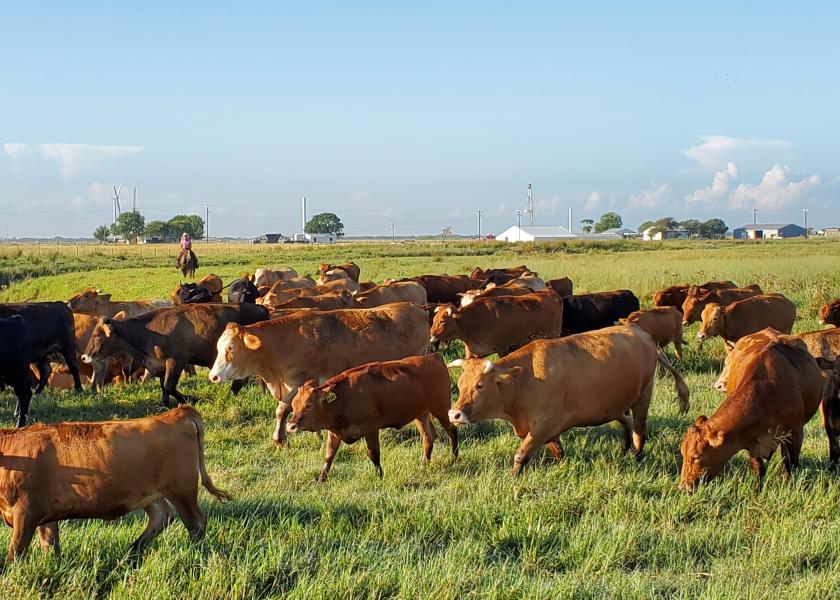I’m a Drover: HeartBrand Beef Brings Opportunity for Texas Producers

Deep in South Texas a unique breed of red cattle called Akaushi have found success in the often hot and somewhat humid climate. Originating in Japan, the breed was developed to withstand the terrain and harsh climate in Kumamoto, which features both mountains and coast, and swings of temperature from very hot in the summer to very cold in the winter. It is hardy, but also bred to provide marbling that Wagyu-like cattle are known for.
The first Akaushi cattle came to the U.S. in 1992 as a herd of eight cows and three bulls, the loophole in which they traveled through, closing soon after. In 1998, Ronald and Jordan Beeman, fourth generation ranchers, became involved with Akaushi cattle through meat sales and ranching. In 2006, they founded HeartBrand Beef to preserve pure Akaushi bloodlines, and with careful management of the cattle, have the largest herd in the U.S., according to their site.
The brand also offers opportunities for producers to find benefits in partnership and premiums they don’t see in the traditional cattle market. Through its buyback program, HeartBrand will buyback cattle that are DNA-verified to a full-blooded Akaushi parent that is registered with the American Akaushi Association. Cattle at all stages are eligible, and it offers a premium on finished cattle that’s higher than the 5-day CattleFax average.
For fifth generation rancher Herff Cornelius of E Cross Cattle Company in Bay City, Texas, a shareholder in the business along with his seven sisters, added value and buyback premiums are part of what drew him to a HeartBrand partnership and Akaushi cattle.
“A big part of their marketing is the buyback premiums that they offer, provided you DNA test the cattle and they're at least 50% Akaushi,” he says. “We've always looked for a way to add value to cattle, being on the Texas coast, without having to turn them black as many other operations do because they don't really work well for us here.”

“We, in turn, sell calves back to them, mostly at weaning age weighing around 600 pounds. We've also partnered with them in owning our cattle through the feedlot,” he says.
Compared to traditional market prices, Cornelius says they see higher value with the Akaushi cattle and buyback program.
“It's anywhere from 15 to 30 cents premium. When we sell them, it equates to about $150 a head over the average market in our area, and we've always tried to sell through private treaty. We feel like HeartBrand is a trustworthy group of people, and that we're treated fairly,” he says.
Another opportunity with the Akaushi cattle is the marbling and grading.
Austin Brown III, a fourth-generation rancher at Brown Land and Cattle in Beeville, Texas, typically crosses the Akaushi with Red Angus cattle, and has seen great return in quality grade.
“Our Red Angus Akaushi F1 feeder steers are grading 30% to 35% prime, while being fed an average number of days on feed. We're not feeding these cattle 300 days. Based on in weights in the feedyard, we’re feeding these feeder calves 140 to 160 or 170 days. And those cattle are grading a very very high percentage Prime. We're doing much better with an Angus-Akaushi cross than what straight-bred Angus cattle can do.”
It’s a testament to the quality of the genetics Brown says. Not only to the Red Angus genetics, but the Akaushi as well, and how powerful they are in passing along the high-marbled beef quality to their offspring.
“It’s a great program, and there's no gimmicks about it. We're not being subsidized for doing this,” he says. “We have to compete in the same cattle market that everyone else has to compete in, and the premiums we see, and the and the quality of cattle that we're able to produce using these Akaushi genetics is tremendous.”
Brown also says that it’s a way for his ranch to generate more revenue in an area where they can’t expand in acreage.
“Because of the nature of the breed and the Akaushi program, with the same amount of overhead and the same amount of inputs as we have had and used in the past, are able to generate more income, he says. “So, this program is not costing us anything, and we’re making more money doing it.”







